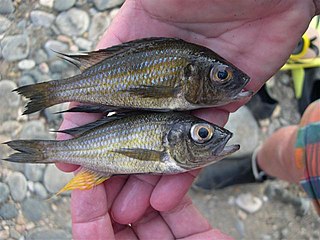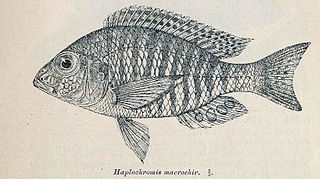
Cichlids are fish from the family Cichlidae in the order Cichliformes. Traditionally Cichlids were classed in a suborder, the Labroidei, along with the wrasses (Labridae), in the order Perciformes, but molecular studies have contradicted this grouping. On the basis of fossil evidence, it first appeared in Tanzania during the Eocene epoch, about 46–45 million years ago. The closest living relative of cichlids is probably the convict blenny, and both families are classified in the 5th edition of Fishes of the World as the two families in the Cichliformes, part of the subseries Ovalentaria. This family is large, diverse, and widely dispersed. At least 1,650 species have been scientifically described, making it one of the largest vertebrate families. New species are discovered annually, and many species remain undescribed. The actual number of species is therefore unknown, with estimates varying between 2,000 and 3,000.

Aulonocranus dewindti is a species of cichlid endemic to Lake Tanganyika and some rivers which flow into it.

Nimbochromis livingstonii, Livingston's cichlid or (locally) kalingono, is a freshwater mouthbrooding cichlid native to Lake Malawi, an African Rift Lake. It is also found in the upper Shire River and Lake Malombe. They are found in inshore areas of the lake over sandy substrates.

Lethrinops is a genus of haplochromine cichlids endemic to Lake Malawi in East Africa. Particularly in the aquarium hobby, they are known as the sandeaters or sandsifters.
Lethrinops altus is a species of cichlid endemic to Lake Malawi where it occurs in areas with sandy substrates. This species grows to a length of 15.8 centimetres (6.2 in) TL.

The golden sand-eater is a species of cichlid fish endemic to Lake Malawi where it prefers shallow waters with muddy substrates. This species grows to a length of 14 centimetres (5.5 in) TL. It can also be found in the aquarium trade.
The greenface sandsifter is a species of cichlid endemic to Lake Malawi where it prefers areas with sandy substrates. This species grows to a length of 19.5 centimetres (7.7 in) TL. It can also be found in the aquarium trade.
Lethrinops gossei is a species of cichlid endemic to Lake Malawi where it is usually found in deep waters with muddy substrates in the southern portion of the lake. This species grows to a length of 14.4 centimetres (5.7 in) SL.

Lethrinops leptodon is a species of cichlid endemic to Lake Malawi where it prefers areas with sandy substrates. This species grows to a length of 20 centimetres (7.9 in) TL. It can also be found in the aquarium trade.
Lethrinops longimanus is a species of cichlid endemic to Lake Malawi where it is found in deep waters 50 to 70 metres over sandy substrates. This species grows to a length of 15.3 centimetres (6.0 in) SL.
Lethrinops longipinnis is a species of cichlid endemic to Lake Malawi where it is found at depths of 30 to 140 metres over sandy substrates. This species grows to a length of 16 centimetres (6.3 in) SL.
Lethrinops lunaris is a species of cichlid endemic to Lake Malawi where it occurs in shallow waters with sandy substrates. This species grows to a length of 18.6 centimetres (7.3 in) TL. It can also be found in the aquarium trade.
Lethrinops macracanthus is a species of cichlid endemic to Lake Malawi where it occurs in deep waters over sandy substrates. This species grows to a length of 20 centimetres (7.9 in) TL.

Lethrinops macrochir is a species of cichlid endemic to Lake Malawi where it prefers shallow waters with a sandy substrate. This species grows to a length of 13 centimetres (5.1 in) TL.
Lethrinops marginatus, also known as the Lethrinops 'rounded head' in the aquarium fish trade, is a species of cichlid endemic to Lake Malawi where it is widespread and occurs in shallow waters over sandy substrates. This species grows to a length of 11 centimetres (4.3 in) SL.
Lethrinops microdon is an endangered species of cichlid endemic to the southern part of Lake Malawi where it occurs at depths of 35 to 100 metres in areas with soft substrates. This species grow to a length of 13.1 centimetres (5.2 in) SL. The species is threatened by trawl fisheries and has greatly declined but little is known about its population and distribution within Lake Malawi, it is given a status of Data Deficient by the IUCN.
Lethrinops oculatus is a species of cichlid endemic to Lake Malawi where it is only known from the southern part of the lake over sandy substrates. This species grows to a length of 13.5 centimetres (5.3 in) TL. It can also be found in the aquarium trade. The 2018 version of The IUCN Red List of Threatened Species treats this taxon as a junior synonyms of Lethrinops marginatus, as does the Catalog of Fishes.
The Lethrinops red flush is a species of cichlid fish endemic to Lake Malawi where it is found over sandy substrates in the southern portion of the lake. This species grows to a length of 14 centimetres (5.5 in) SL.
Lethrinops stridei is a species of cichlid endemic to Lake Malawi where it occurs at depths of from 15 to 55 metres in areas with sandy substrates. This species grows to a length of 13 centimetres (5.1 in) SL. The specific name honours Kenneth E. Stride, who introduced successful commercial trawling to Lake Malawi, and this species is now very rare in Lake Malawi and is threatened by overfishing by commercial trawlers.
Aulonocara koningsi is a species of haplochromine cichlid which is endemic to Lake Malawi. It is restricted to the waters around Mbenji Island and is therefore endemic to Malawi too. It is common in the restricted area in which it occurs but collection for the aquarium trade does not seem to have affected the population.







